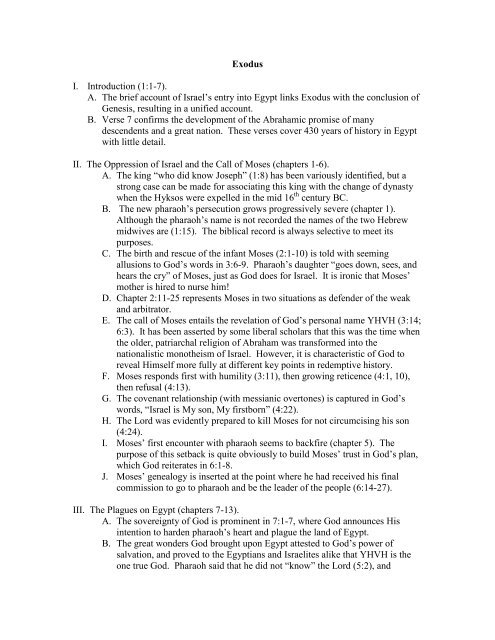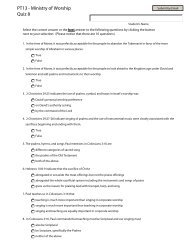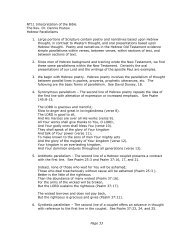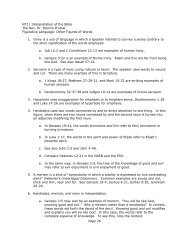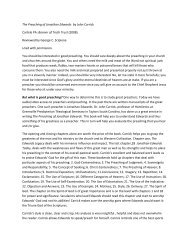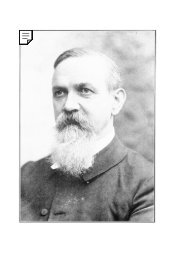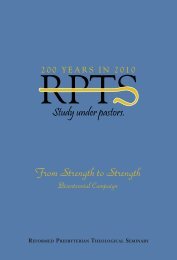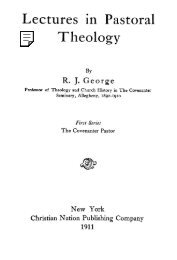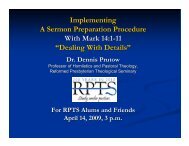Exodus Outline
Exodus Outline
Exodus Outline
You also want an ePaper? Increase the reach of your titles
YUMPU automatically turns print PDFs into web optimized ePapers that Google loves.
<strong>Exodus</strong><br />
I. Introduction (1:1-7).<br />
A. The brief account of Israel’s entry into Egypt links <strong>Exodus</strong> with the conclusion of<br />
Genesis, resulting in a unified account.<br />
B. Verse 7 confirms the development of the Abrahamic promise of many<br />
descendents and a great nation. These verses cover 430 years of history in Egypt<br />
with little detail.<br />
II. The Oppression of Israel and the Call of Moses (chapters 1-6).<br />
A. The king “who did know Joseph” (1:8) has been variously identified, but a<br />
strong case can be made for associating this king with the change of dynasty<br />
when the Hyksos were expelled in the mid 16 th century BC.<br />
B. The new pharaoh’s persecution grows progressively severe (chapter 1).<br />
Although the pharaoh’s name is not recorded the names of the two Hebrew<br />
midwives are (1:15). The biblical record is always selective to meet its<br />
purposes.<br />
C. The birth and rescue of the infant Moses (2:1-10) is told with seeming<br />
allusions to God’s words in 3:6-9. Pharaoh’s daughter “goes down, sees, and<br />
hears the cry” of Moses, just as God does for Israel. It is ironic that Moses’<br />
mother is hired to nurse him!<br />
D. Chapter 2:11-25 represents Moses in two situations as defender of the weak<br />
and arbitrator.<br />
E. The call of Moses entails the revelation of God’s personal name YHVH (3:14;<br />
6:3). It has been asserted by some liberal scholars that this was the time when<br />
the older, patriarchal religion of Abraham was transformed into the<br />
nationalistic monotheism of Israel. However, it is characteristic of God to<br />
reveal Himself more fully at different key points in redemptive history.<br />
F. Moses responds first with humility (3:11), then growing reticence (4:1, 10),<br />
then refusal (4:13).<br />
G. The covenant relationship (with messianic overtones) is captured in God’s<br />
words, “Israel is My son, My firstborn” (4:22).<br />
H. The Lord was evidently prepared to kill Moses for not circumcising his son<br />
(4:24).<br />
I. Moses’ first encounter with pharaoh seems to backfire (chapter 5). The<br />
purpose of this setback is quite obviously to build Moses’ trust in God’s plan,<br />
which God reiterates in 6:1-8.<br />
J. Moses’ genealogy is inserted at the point where he had received his final<br />
commission to go to pharaoh and be the leader of the people (6:14-27).<br />
III. The Plagues on Egypt (chapters 7-13).<br />
A. The sovereignty of God is prominent in 7:1-7, where God announces His<br />
intention to harden pharaoh’s heart and plague the land of Egypt.<br />
B. The great wonders God brought upon Egypt attested to God’s power of<br />
salvation, and proved to the Egyptians and Israelites alike that YHVH is the<br />
one true God. Pharaoh said that he did not “know” the Lord (5:2), and
epeatedly the Lord says that the plagues are “so that you may know that I am<br />
the Lord.”<br />
C. The plagues are divided into three groups of threes, leading up to the tenth<br />
plague as the climax. Each series of three begins with nearly the same phrase<br />
(7:15, 16; 8:20; 9:13). The first in each series is announced in the morning,<br />
the second in the pharaoh’s palace, the third comes without warning. This<br />
pattern shows the structure of the events and the unity of the account.<br />
D. The tenth and most terrible plague is the context for the institution of Passover<br />
(chapter 12), highlighting the concept of salvation by the blood of a<br />
substitutionary sacrifice. In every respect, the Passover meal is designed to<br />
set apart God’s people.<br />
IV. The <strong>Exodus</strong> from Egypt (chapters 12-18).<br />
A. Though some scholars put it in the 13 th century BC, the <strong>Exodus</strong> most likely<br />
took place in or about the year 1445 BC (for a detailed study of this issue see<br />
Archer’s Introduction, p. 230ff.). The Merneptah Stela confirms that Israel<br />
was settled in Canaan at least by 1229 BC.<br />
B. The population of Israel during the <strong>Exodus</strong> has been the subject of debate<br />
(12:37). Some have argued that the Hebrew word eleph (“thousand”) refers to<br />
a family, clan, or military unit.<br />
C. The identity of the “Sea of Reeds” has been disputed, but whether it was the<br />
Red Sea or a freshwater lake in northern Egypt, Israel’s crossing is clearly<br />
miraculous. The event had its intended effect on pharaoh (14:28) and Israel<br />
(14:31).<br />
D. The Song of Moses has been the object of endless higher criticism, as it seems<br />
to follow the pattern of The Baal Cycle (conflict, victory, enthronement).<br />
However, it is clear that Moses’ song extols the unique character and acts of<br />
YHVH in an original manner.<br />
E. The praise of Moses gives way to the complaints of the people, yet God<br />
faithfully provides their food and drink in spite of their weak faith and<br />
ingratitude (15:22-17:7). It is noteworthy that God’s salvation and sustenance<br />
precede the giving of the law. Chapter 16 demonstrates that the Sabbath<br />
ordinance was known and practiced before the Decalogue was given.<br />
F. At the advice of Jethro, Moses appoints elders to judge for the people (chapter<br />
18). This arrangement is reflected in the plurality of elders in the New<br />
Testament church.<br />
V. The Covenant at Sanai (chapters 19-24).<br />
A. It has been ascertained that the form of the covenant in this portion of <strong>Exodus</strong><br />
bears similarities to Hittite Suzerainty Treaties, although it is hasty to deduce that<br />
such treaties had a direct influence on the Sinai Covenant.<br />
B. In Ex. 19 the covenant with Abraham is renewed to his descendents now that they<br />
had become a nation. The scene at Sinai impresses the holiness and power of<br />
God; the people are called “holy” for the first time, and Moses continues in his<br />
appointed role as mediator.<br />
C. A reiteration of God’s character and grace precede the law (20:2).
D. The law, summarized in the Decalogue, is meant to regulate and perpetuate the<br />
gracious covenant relationship.<br />
E. The first four commandments deal with the God-man relationship; the last six<br />
deal with the man-man relationship. The tenth commandment addresses the inner<br />
man, which is unique among ancient codes of law. The law of the altar, which<br />
immediately follows the Decalogue (20:22-26), implies that there is provision<br />
made for forgiveness when the law is broken.<br />
F. The laws which closely follow give detailed application of the principles<br />
contained in the Decalogue (chapters 21-23). Some of the laws are couched in the<br />
context of ancient life, but their abiding principles can always be discerned and<br />
applied.<br />
G. The “Book of the Covenant” is read and the people commit themselves to God in<br />
chapter 24.<br />
VI. The Tabernacle and Priesthood (chapters 25-31).<br />
A. We should resist the temptation to look for hidden meaning among the details<br />
of the Tabernacle and its instruments (chapters 25-27). O.T. Allis counseled,<br />
“The study of symbolics is interesting and instructive, but it is full of<br />
difficulty, and it is easy to lose one’s way in it.” The precision and<br />
ornamentation with which the Tabernacle was built simply reflect the holiness<br />
of God and His sovereignty over the way He is worshipped. The Tabernacle<br />
impresses the fact that God dwells with His people, but apart from them in<br />
unapproachable holiness.<br />
B. Aaron and his sons were appointed to the office of priest, the function of<br />
which was to mediate between Israel and God, as indicated by the fact that the<br />
names of the twelve tribes were inscribed on the shoulder pieces of the<br />
priestly ephod (28:9-12).<br />
C. The elaborate, seven day ceremony of the consecration of the priests is<br />
described in chapter 29. This underscored the sovereignty of God in how, and<br />
by whom, He may be approached.<br />
D. The entire description of the Tabernacle and its instruments, along with the<br />
priests and their preparation, underscores the holiness of God, the<br />
unworthiness of man, the need for a God appointed mediator, and the<br />
necessity of blood atonement for sin.<br />
VII. Apostacy and Renewal (chapter 32-34).<br />
A. It is quite incredible that Israel would degenerate to such apostasy so soon<br />
after saying, “All the words which the Lord has said we will do” (24:3).<br />
B. The calf or bull was a common representation of the Egyptian god Apis.<br />
C. Aaron’s declaration of a feast to YHVH is an example of syncretism (32:5).<br />
D. Moses’ seemingly odd question in 32:11 limits itself to God’s interest in<br />
preserving His name and glory.<br />
E. Moses again intercedes for Israel, calling to remembrance the history of the<br />
covenant before God (32:11-13).<br />
F. God’s character and interaction with Moses is realistic (32:7-14). Intercessory<br />
prayer is meaningful and effectual.
G. Moses was offered his own legacy (32:10), but instead offered himself up to<br />
be punished in place of the people (32:32). This reinforces his role as<br />
mediator.<br />
H. The revelation of God’s goodness to Moses in 33:19 is a mysterious<br />
occurrence that is beyond our power to explain. What is clear is that God<br />
revealed Himself very intimately to Moses, “face to face.”<br />
I. The covenant is renewed, and God stays true to His promises in spite of the<br />
sin of the people (chapter 34). This chapter underscores the forgiveness of<br />
God, especially in the exalted statement of the divine nature in 34:5-7.<br />
VIII. The Completion of the Tabernacle (chapters 35-40).<br />
A. The account of the Tabernacle begins again where it left off, with an emphasis<br />
on keeping the Sabbath during its construction (31:12-18; 35:1-3).<br />
B. This section is a close repetition of chapters 25-31, describing how Moses<br />
carried out the instructions for the Tabernacle. God’s directions are put into<br />
precise effect.<br />
C. The completion of the Tabernacle was an external pledge of God’s presence<br />
and the permanence of His covenant. Throughout this process the people<br />
learned of their need of a prophet (Moses) and a priest (Aaron) to mediate<br />
between them and God.<br />
D. Some scholars have noted parallels between this passage and the creation<br />
account. While there are positive points of comparison, it is not clear that the<br />
connection is intended.<br />
IX. Supposed “Post-Mosaica” in <strong>Exodus</strong>.<br />
A. It has been contended that several passages in <strong>Exodus</strong> point to a later author<br />
than Moses (6:26, 27; 16:34, 36).<br />
B. The perspective of Ex. 6:26, 27 is not necessarily past tense. The phrase<br />
“These are the same Aaron and Moses…” can be explained by the fact that it<br />
is found in a genealogy, and is meant to clarify and establish whose<br />
genealogy.<br />
C. When the author stipulates the time as “before the Testimony” (16:34), his<br />
standpoint need not be later than Moses’ life.<br />
D. The explanation of an omer (16:36) does not necessarily indicate a later<br />
explanatory gloss. The use of this term as a unit of measure is unique to<br />
<strong>Exodus</strong> 16, and it is natural for an explanation to be included.


